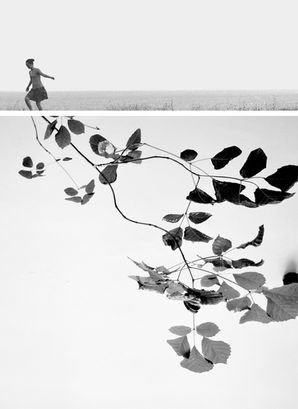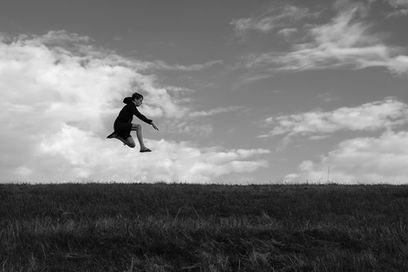
SYNESTHESIA
August 27, 2021
INTERVIEW
PHOTOGRAPHY Pan
INTERVIEW Bill Lacey
Pan is a street photographer living in the Bronx. We leave it to Pan to describe what photography is to him.

“Photography is the jazz or the sounds of the blues, the city streets, the neon signs, a thousand and one taxi cabs, all those hats and coats, a myriad of beards and legs and eyebrows and hair and hands, the beaches, tiny apartments and stairwells, parties until five a.m., costumes on Halloween and any day of the year, the cockroaches and fireflies, the actors, singers, musicians, and photographers, the blind and the seeing and the blind who saw more than him, and all the countless grays and colours too.”
IN CONVERSATION WITH PAN
THE PICTORIAL LIST: Pan, please tell us about yourself. How did you become interested in photography?
PAN: I am a photographer living in the Bronx; well, to be transparent, in Marble Hill, which is technically Manhattan, but culturally part of the Bronx.
My path into being a photographer might be a little different than most. I was introduced to the medium through a class in this special high school artist program. I was mostly painting then, and photography didn’t interest me much. I was kind of bored, but then, this man from Kodak came and showed us this weird tool, a digital camera. This was the early 1990’s, and digital cameras were not really available then; they cost upwards of $20,000. Kodak made this machine with a sensor that attached to a Nikon camera, and the Kodak person let us high school kids experiment with this fantastically expensive camera in the garden behind the photo lab. I remember taking that test camera and photographing all these flowers; then downloading them slowly onto a computer, and printing them on a dot matrix printer, really big. That was really a shift in my perception.
I used photography off and on as a tool to do something else artistically from that point. In the 2000’s, I was using very low-resolution video images as photographs, sent a camera into the upper atmosphere, stuff like that. But all this was photography to do something else. Then, maybe about ten years ago, I was working with the photographer Sean Hemmerle, on a video installation using his photographs. He was very proficient technically with photography, but more importantly, he was passionate about the medium, and knew its history and possibilities. I saw I didn’t really understand photography that well. So, I decided to really learn the art, learn its history, go back to basics, learn it as a photographer, on its own terms, not as a painter or experimental artist. I read books, learnt exposure, went to every photography exhibition in New York around, bought a film camera, built a darkroom, taught myself all over again, from scratch. And… it kind of took over my life. I guess what interested me was photography’s ability to observe the outside world, with its own slant. Now, I can’t even think of myself except as a photographer anymore.
TPL: Where do you find your inspiration? And do you have a favourite place to shoot?
PAN: John Szarkowski talked of photography as mirrors versus windows, looking inside the photographer’s mind or outside at the world. I am a window photographer. So, I spend time photographing on streets, in the subway, in parks, beaches, anyplace in New York my feet will carry me. I am not interested much in myself, but very curious about other people.
When I took on this project on COVID-19, it was natural then to use walking the streets as my method to think through this. I was seeing other photographers take self-portraits, and I saw lots of pictures taken in Times Square, empty of people. Those didn’t resonate with me. I wanted to see how the people around me were, so I put on my shoes, went out and walked the Bronx.
This was the first time though I photographed specifically in my own neighborhood. I remember going to a lecture by the photographer Mark Power given at the Bronx Documentary Center, and he talked about how photographers tend to go far away to take pictures, but there is something to be learned in photographing one’s own town or borough or neighborhood. He brought these photographs he had made that morning in the Bronx, and I thought, why am I not doing that?”
*Editor's Note: Read Pan's story RESILIENT BRONX via the link below.
TPL: In general, what do you want to express through your photography? And what are some of the elements you always try to include in your photographs?
PAN: It depends on the project. With the pictures I’ve been making in the Bronx, my hope is that they express the worry about losing one’s job, fear of getting sick, lonesomeness from isolation, sense of looking out for one another, being “New York tough”, all those things I see in people when I walk around and take pictures.
I really had to change my approach and my compositions to fit that idea. I consciously was working to simplifying compositions, to give them weight and gravity equal to these times. So that the trouble we are living through, was felt in the image. It’s the first time I tried to make lines vertical and horizontal, for example. I think this is interesting, trying to make my style suit the images in a project.
TPL: Do you have any favourite artists or photographers you would like to share with us, and the reason for their significance?
PAN: Well, lots, but to choose one, Walker Evans. I looked at a lot of his work while making these recent images. Garry Winogrand said Evans wasn’t in his photographs, they were just photographs, pure photographs. That is an incredible achievement; to make a picture that isn’t about the photographer, it's just the image in itself. They’re so deceptively simple. A house, a sign, a man on his porch, some painted letters. But the power in his images, it’s a real inspiration.
TPL: Does the equipment you use help you in achieving your vision in your photography? What camera do you use? Do you have a preferred lens/focal length?
PAN: So, for the Bronx project, I used an iPhone. Besides the obvious, its small and the images are instantly available, a phone was important here because I needed to make sure people understood I wasn’t an outsider. In the Bronx, a camera is not a common sight. Having my film camera would have set me at a considerable distance, presented me as an outsider. Sometimes it’s okay to be an outsider, but this time, when I was taking a picture of someone, I wanted them to know I’m from the Bronx, and the phone helped with that. Also, its limitations, the slower speed of the sensor and its operation, helped me plan more simple, direct compositions, which in turn had that sense of weight I think is important.
TPL: Do you have a favourite quote,lyric or saying that especially resonates with you? And why?
PAN: Garry Winogrand said he “photographed to see how something looks as a photograph”. I might have gotten the quote a little wrong, but his sentiment was a photograph is its own frame, it is divorced from the world a little even when it is a picture of the world. Look at it as a photograph. As lines, light, shadow, forms. That is advice I think about everyday. It makes for better composition when I am looking at a scene through the viewfinder, because if a photograph isn’t a good composition, as a photograph, as uniquely a photograph, and not an illustration, then it doesn’t work.
I spend time photographing on streets, in the subway, in parks, beaches, anyplace in New York my feet will carry me. I am not interested much in myself, but very curious about other people.

TPL: Do you have a favourite place to shoot in?
PAN: I guess I should be clever and say the Bronx! But I will like traveling with my camera someday.
TPL: When you go out on the streets, do you have a concept in mind of what you want to shoot, or do you let the images just "come to you", or is it both?
PAN: With this recent work, I had a concept of "COVID-19” in mind, which normally I would not have when photographing. That guided every time I pressed the shutter. Honestly one of the great things about this project personally has been deliberately stepping outside of my typical ways, because the project demands that. The project forced me to do things differently.
TPL: What are some of your goals as an artist? Where do you see yourself or hope to see yourself in five years?
PAN: I simply hope to be making better photographs in five years, keep my curiosity, keep working. It would be interesting if my photography was completely different in five years though. That would be a fun story.
TPL: Are there any special projects you are currently working on that you would like to let everyone know about?
PAN: Covid-19 isn’t over, and the ways it has changed the Bronx are not over. So, my main priority is sticking to this story, deepening it, and getting it out there. I am currently working on making a series of portraits, using large format film, for this, to ground the work on people. Because this is a story about people in the end. Ultimately, I would love this work to be shown right here in the Bronx, so my neighborhood can think about it, reflect, consider where to go and what these past months mean.
TPL: "When I am not out photographing, I (like to)…
Walk. Thoreau wrote, “I think that I cannot preserve my health and spirits, unless I spend four hours a day at least—and it is commonly more than that—sauntering through the woods and over the hills and fields, absolutely free from all worldly engagements.”































